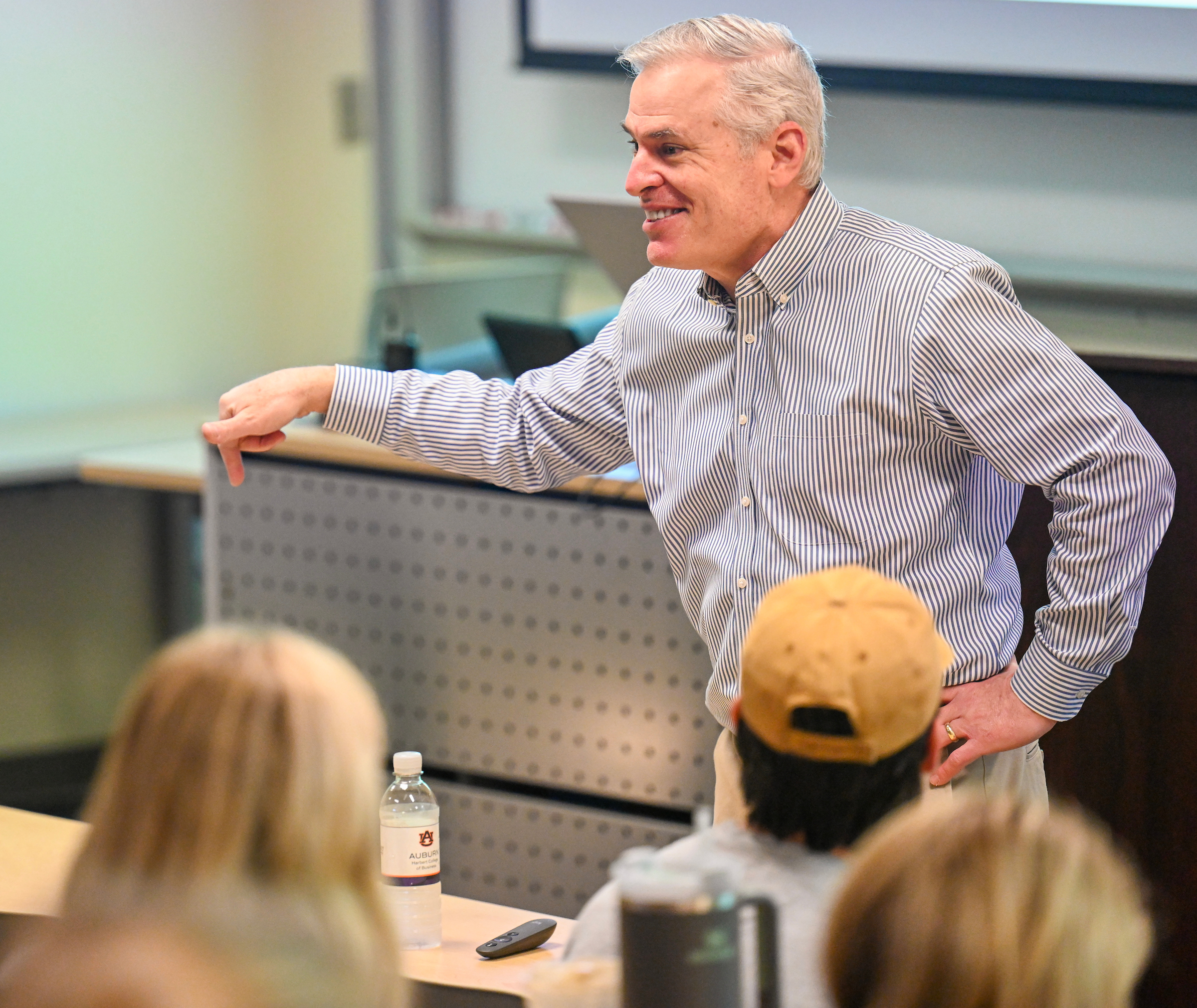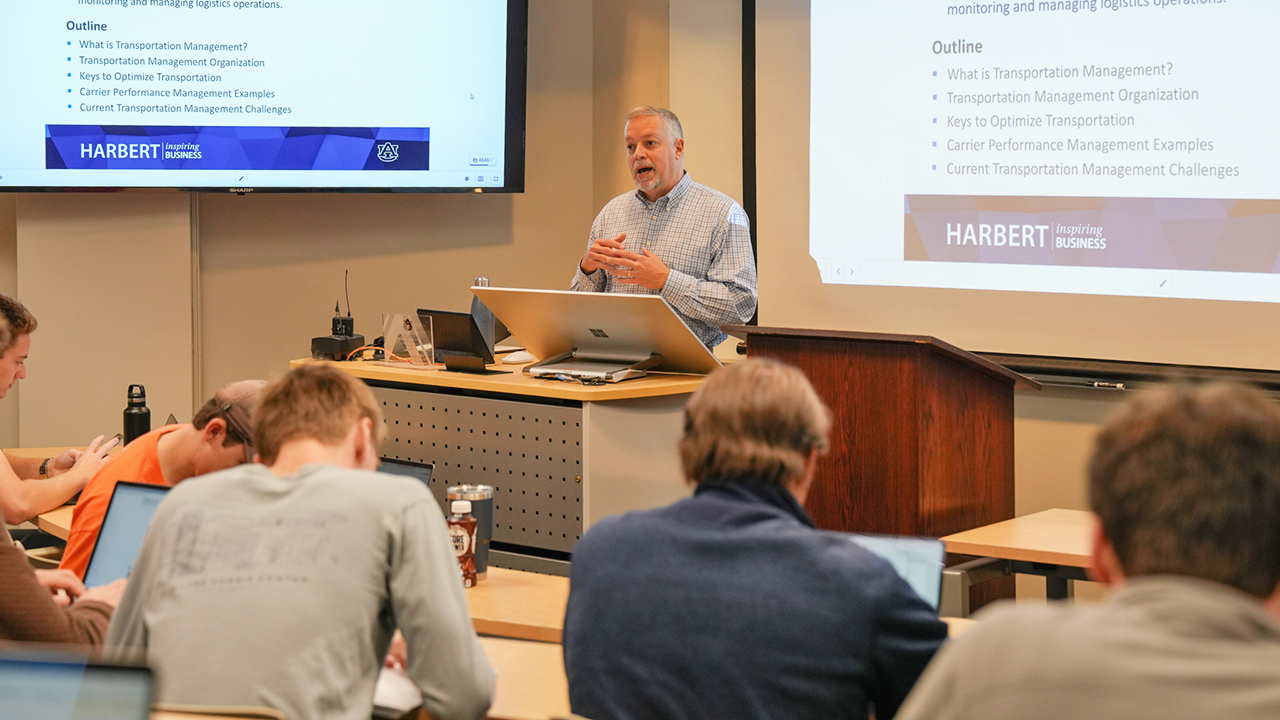Sometimes the best way to figure out what works most for a team is to first figure
out what doesn’t work, said noted author, consultant and teamwork expert Patrick Lencioni during a Feb. 2-3 round of talks with Auburn University students.
 |
Patrick Lencioni, author of "The Five Dysfunctions of a Team," spoke to Auburn University
students Feb. 2-3, 2023. Photo by Julie Bennett, Media Production Group
|
Lencioni began his speaking engagements with a presentation to Harbert College of Business MBA and undergraduate students, offering them several ways to identify strengths,
weaknesses and solutions to successful team building. He also planned to meet in separate
sessions with the Auburn baseball and Lacrosse teams.
His primary theme: Match team players to their greatest strengths and interests, and
avoid forcing them into roles perceived as their greatest weakness or disinterest.
The author of “The Five Dysfunctions of a Team” and at least a dozen other books, Lencioni travels the nation speaking to all levels
of leadership at major corporations, sports teams, schools and universities, and various
other organizations to help them improve teamwork and leadership skills.
He revealed a personal connection to Auburn.
“My son just transferred here to Auburn last summer from a school in California, and
we just love it here,” Lencioni said. “The people who go here are down to earth and
they work hard. YOU are going to be successful if you just keep working hard.”
Overcoming the five dysfunctions
Lencioni’s “Five Dysfunctions” book analyzes challenges that need to be recognized
and strategically managed, he said.
Absence of trust
The fear of being vulnerable with team members prevents the building of trust within
the team.
“If you don’t have trust, you are not going to have a successful operation,” he said.
“If you build trust on a team, it changes everything. If you don’t, the ceiling is
so low.”
He recommends leaders and team members make sincere efforts to get to know each other
in a more personal manner, such as in introductory exercises where more than just
a few seconds of sharing is involved. Instead, he suggested spending longer quality
time asking thought-provoking questions, and better understand each other’s special
interests, as well as their most-dreaded assignments.
“Too many don’t know how to put it on a spreadsheet: Where does trust go?” he said,
pointing out that understanding the value of trust is more important than trying to
fit it on a spreadsheet analysis.
Fear of conflict
The desire to preserve artificial harmony stifles the occurrence of productive, ideological
conflict.
Conflict, if handled in a productive manner among colleagues who trust each other,
is a good thing and a tool that can lead to success in reaching goals, Lencioni said.
Avoid disagreements and conflict with people you don’t trust, “but when on a team
that trusts each other? Yes. The only way to have a healthy conflict is to create
trust.... Great companies have trust in each other,” so when conflict surfaces, “they
have it out!” he said.
“When you don’t have that conversation” involving conflicts, “trainwrecks happen,”
he said. “Conflict is good.”
Lack of commitment
The lack of clarity or buy-in prevents team members from making decisions they will
stick to.
Conflict in a trust environment allows disagreement to be aired, considered and addressed,
which leads to commitment from members of the team, Lencioni said. “You have to have
that discussion.”
Commitment should go beyond verbal response and be solicited from team members with
their individual strengths and interests in mind, he said. And “avoid having an ‘alligator
army” in which everyone says one thing, such as “oh, how can I help?” but have short
arms in reaching out to act.
Avoidance of accountability
The need to avoid interpersonal discomfort prevents team members from holding one
another accountable for their behaviors and performance.
The “alligator army” can lead to the next dysfunction, which is an avoidance of accountability,
he said. “You won’t have accountability without commitment.”
He also noted the best source for creating team commitment.
“When you’re on a team, the best form of accountability is not from a boss or coach,”
Lencioni said. “It’s from a teammate.”
He cited several examples of championship sports teams that succeeded because in larger
part, it was teammates who stepped up and demanded accountability of one another.
Inattention to results
The pursuit of individual goals and personal status erodes the focus on collective
success.
Understanding the goal of results and clarifying them on both an individual and team
level is important, Lencioni said, and the failure to recognize the difference can
be another dysfunction preventing final success.
“We’re talking about collective results of the team. We’re not talking about individual
results. You have to make the collective good more important than your individual
desire,” he said. “That’s often difficult.”
Auburn football’s Cadillac Williams provided Lencioni a prime example for the Harbert
students.
“Cadillac taking over the football team, he gave it a booster shot!” he said. “It
was amazing” how Williams, a former star player who became interim coach, focused
on the collective good instead of his own personal goals and reunited a team and its
fanbase. “I love what Cadillac did!”
There are examples of individual goals being important in team results, Lencioni said,
such as certain positions in sales; or in sports, a golf team, where individual play
matters most and then scores are tallied. Yet, it is support of one another that helps
a team reach its desired results.

 Degrees & Programs
Degrees & Programs
 Faculty & Staff
Faculty & Staff
 Career Development
Career Development
 Recruiters & Industry
Recruiters & Industry



